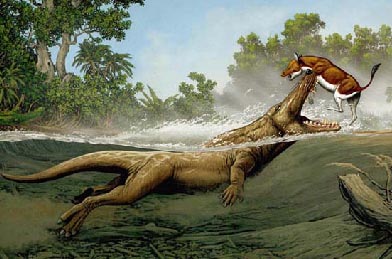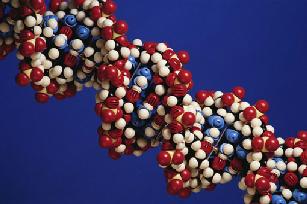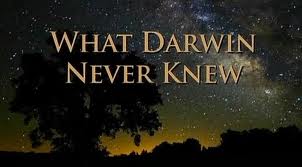
Evolution - Foundations

 |
The subject of evolution is a very important one in the field of biology. Ever since Charles Darwin and Alfred Wallace proposed the theory in 1859 the way we look at the world, ourselves as well as the dynamic change of species within it, was altered. Evolution permeates every level of biology from ecosystems to the organism as well as the world of the cell. It is crucial that a beginning biology student gets a solid foundation of the facts of evolution since nothing truly makes sense in biology without them. This section of the course focuses on an introduction to evolution and natural selection with an emphasis on macroevolution. These principles will be a valuable tool as you continue to study the different aspects of zoology this semester. |
Lecture Outline/Notes:
| Introduction/Background:
Evolution (definition) Marine Iguanas Older ideas: Greece Scala Naturae / Life is static and unchanging Prevailed for about 2,000 years Changes - The Scientific Revolution Use of the scientific method Challenges to the idea of a young Earth and static species Field of Geology (Hutton/ Lyell) The Fossil Record (Cuvier) The concept of change (Lamarck) [understand Lamarck's incorrect theory of "the inheritance of acquired characteristics" (example: giraffes)] |
Charles Darwin
Background Voyage of the Beagle - 1831-36 Discoveries on the voyage South America The Galapagos The Marine Iguana Tortoises Darwin's Finches Thomas Malthus Role of Variation Charles Darwin published "On the Origin of Species by the Means of Natural Selection" in 1859. The introduction to the book is quite interesting. Read the book online! : - ) |
![Charles Darwin [1809-1882] published the Origin of Species in 1859. The idea that species changed was not new, but Darwin brought together the evidence and proposed a mechanism for the change.](darwin.gif)
|
![Alfred Russel Wallace [1823-1913]](wallace%5B1%5D.gif) |
Alfred Wallace's work and travels; co-discovered the theory of natural selection (selections of his work). As a young naturalist Wallace traveled extensively through the Neotropics as well as the Malayan Archipelago. These years are well described in the first part of David Quammen's book "The Song of the Dodo". Wallace independently developed the mechanism for evolution based on his extensive observations of the natural world. |
 Is
Evolution
Just a Theory? [video 6 minutes] Is
Evolution
Just a Theory? [video 6 minutes] |
1. Taxonomy and
Systematics:
Classification
of organisms with the help of taxonomy
and systematics leads to the separation of species into "natural"
groups.
What does "natural" refer to in this context? What degree of
evolutionary
relatedness can be associated with these groups (taxa)?
| 2. The
Fossil Record definition: remains of life from the past more than 300,000 species of fossil organisms have been described formation of fossils record of past life some species dominate in the fossil record the record is biased because: (linked to.. hard parts present (bone/shell) habitat (oceans, close to wetlands, rivers) abundance (high population) distribution (large area) prevalence in time (all species go extinct - the longer a species exists the more likely they will be part of the record) (In addition: consider surviving geological destruction and being found by a curious human) The evolution of horses is a prime example of evolutionary change huge and solid record of fossils from these taxa visible changes in size, toes, teeth cause of change: climate changes? There are numerous transitional fossils in the fossil record Whales evolved from terrestrial animals. The ancestors to modern whales had legs as shown by the fossil record. Changes in the fossil record of animals over time Role of Extinctions |

|
3. Comparative
Anatomy
Biologists compare different
anatomical features of organisms. Similarities and differences in
anatomy
can provide evidence about evolutionary relatedness.
Example: homologous
structures
e.g.
limbs
of birds, humans, porpoise, reptile and a bat
Functions
are different but the structures have the same evolutionary origin.
Analogous
Structures
Vestigial
Structures (e.g. in the skeletons of the Greenland
whale and the python snake
one
can still find the rudiments of limbs).
4. Comparative
Embryology
Comparing the early
development
of organisms. Try
it
out!
Study the images
of the early development of several classes of the vertebrates. These
embryos
are very similar at early stages but quite different as development
proceeds.
E.g. gill arches present in
all of them at an early stage. Why? In a fish these structures are
part
of the gills while in a human they become part of the middle ear. Why
do
they form during the early stages?
Compare
the
development of four different embryos.
These
organisms
seem to follow the same developmental sequence during the early stages
but take their own unique path as time goes on. The developmental
process
has been modified by evolution. The similarities during the early
stages
point to common descent, i.e. the vertebrates have a common ancestor
about
500 million years ago.
5. Biogeography
The study of the
distribution
and abundance of life forms. Understanding historical geography is
crucial
for being able to explain the current distribution of organisms as
well
as the presence of fossils of life from the past.
Plate
tectonics
The continents move
(continental
drift)
Film
showing
the movement of the continents over the last 700 million
years.
The global geography has
shifted
drastically over this time.
As a biologist it is
important
to consider the geography of the past to be able to understand the
current
distribution of species on the planet.
| 6. Molecular
Biology [Note: Darwin had no knowledge about genes and DNA even though he was aware of the fact that traits were passed down through time from parents to offspring]. Evolutionary changes on the level of DNA (in the genes) are often referred to as microevolution. The sequencing and comparison of DNA has become a powerful tool in terms of understanding the evolutionary relatedness between different species. Certain important genes are relatively stable and change very slowly over time. This phenomenon is referred to as the molecular clock. By comparing the changes that have occurred in the genes between different living species we gain knowledge about the time that has passed since these organisms had a common ancestor. The more similar the sequences the closer the connection in time. The great apes are genetically very similar to us humans. Graphs showing the similarities between major taxa of organisms. |

|
| The Mechanisms: Natural
Selection Definition Natural selection is just one out of many mechanisms that drives evolution. It is the one that is most well known as it is associated with Charles Darwin. Discussion of artificial selection/breeding as a comparison e.g. the mustard plant family and other crops (corn, wheat, rice) e.g. the breeding of dogs, horses, pidgeons and domestic animals in general
Natural Selection
Examples of
natural selection: It is important to remember that the population evolves over time (and not the individual). |

|
|
 |
|
 |
Maps of the Past:
| |
Recommended Readings:
|
 |
|
|
||
| Page created
by: Peter
Svensson Updated: February 11, 2015 |